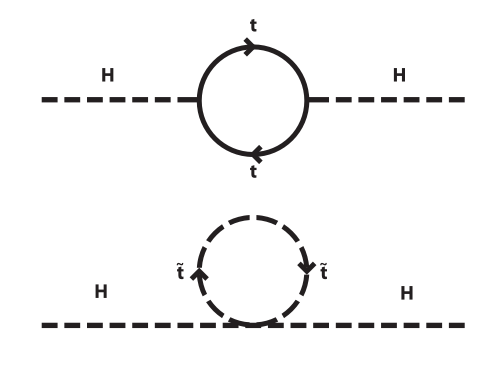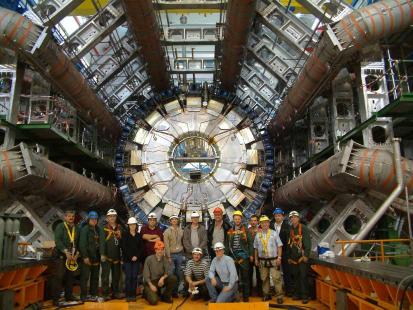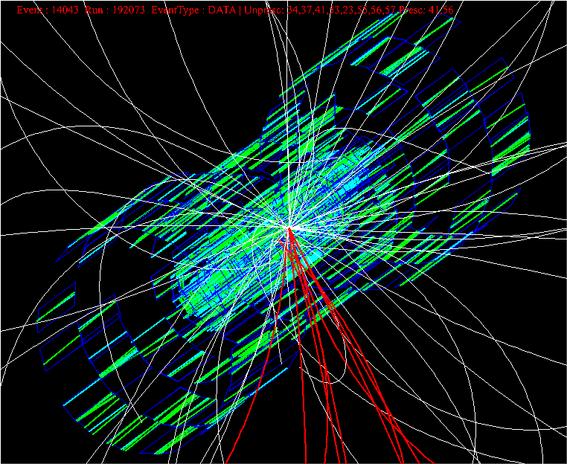"The subject of gambling is all encompassing. It combines man's natural play instinct with his desire to know about his fate and his future." -Franz Rosenthal
Last month, Sean Carroll asked the blogosphere to give their personal odds on whether various theories will turn out to be true or not.
And so I thought it would be a lot of fun to take a look at some of the best theories or most renowned theories and ideas out there today, and to tell you, if I were a Las Vegas bookmaker, what are the odds I would give you on various ideas. (If you know of an idea you want my odds on, leave it in the comments, and I'll try to make this an ongoing series!)

The first idea I thought I'd take on is supersymmetry, or SUSY for short, and the hope that the LHC will find it. In short -- and this is coming from a cosmologist, not a particle theorist -- SUSY is a beautiful idea.
Where does it come from? Let's take the fundamental constants of the Universe that we know about, to help us understand this.

There's Planck's constant, h, which defines the quantum transitions between interacting elementary particles.

There's also the gravitational constant, G, that shows up in both Newton's and Einstein's theories of gravity, and defines how mass and energy either (depending on how you look at it) attract one another or bend spacetime.

And there's the speed of light in a vacuum, c, that shows up everywhere in physics, and is the speed limit of the Universe.
Now, we can combine these three fundamental constants -- the constants that determine the properties and interactions of the elementary particles -- to give us things like a mass. In fact, if we do, we get a quantity known as the Planck Mass, which you might expect to be somehow related to the masses of the particles we find in the Universe.
But not only is that not the case, it isn't even close. The heaviest known particle, the top quark, is seventeen orders of magnitude lighter than the Planck Mass, or 0.000000000000001% of what we might expect it to be.
And so, you ask, why is it that way? In physics, we call this the hierarchy problem. And SUSY is the most popular way to solve it.

And the way it solves it -- conceptually -- is that for every particle that exists, there's a superparticle partner with similar properties (but a different spin) that cancels out, almost exactly, this very large mass.
And this is a great, beautiful, compelling idea. It also gives a great dark matter candidate particle -- the neutralino -- and it also lets you unify the coupling constants at a high energy. And, despite all of the wonderful things it does, I think it's wrong.

Because if SUSY were a good symmetry, the superparticles and the particles would have the same masses. Or, if not the same masses, they'd at least be close enough to one another that it wouldn't make a new hierarchy problem, where the masses of the superparticles are much greater than the masses of the normal particles.
And yet, here we are. More than 15 years after the discovery of the top quark, we're almost ready to declare that the superpartners have a lower limit on their masses that's higher than the heaviest normal particle!

In fact, the latest results from ATLAS, above, one of the two giant detectors at the LHC, show that there's no evidence for many of the particles all the way up to 700 GeV, or over 100,000 times the mass of the electron and the two lightest quarks.
Which means, unless they find something awfully soon, even if supersymmetry exists, it won't solve the problem it was designed to solve.

And, as I've written before, that will be the nightmare of particle physics come true, that they find the Higgs and nothing else. Why? Because that means they'll never build another giant particle collider again!
The alternatives to solving the hierarchy problem -- theories like technicolor -- are in many ways even worse. But the evidence is what it is, and things are looking awfully grim, without a hint of new fundamental particles yet.

And I want to be more optimistic about it. I want this beautiful theory to be correct. The idea of unification is great. (But the proton doesn't decay.) And a lot of SUSY's predictions are fantastic! (But there are no flavor-changing neutral currents.) And the neutralino is the perfect dark matter candidate. (But there are many, many others.) But if I had to make odds, I would say you're better off playing a single number on a roulette wheel than that the LHC will find SUSY. Although I personally think the odds are about 200:1, a lot of people will be willing to bet in favor of the LHC finding SUSY, so I'd probably make the odds a little shorter: maybe a $20 payout for a $1 bet.
But if you can't find SUSY at the LHC, you don't even solve the hierarchy problem with it. It might be back to the drawing board, but that's where my money would be, if I were a betting man.
What are your thoughts, and what would you like to see next?



It would seem that most of the very expensive, high level research done in various fields of science generally amount to an enormous gamble and perhaps this is why we often ask government to at least help foot the bill. It would certainly be a shame for researchers to successfully find an answer that also serves to lock the doors of their facility, but sometimes that's the price you pay for being so smart as to know when to quit. On the other hand when failures continue to be funded indefinitely then things actually mirror most of what the government does anyway.
how about verlinde's ideas? loop quantum gravity? universe collision scars in the microwave background? the ekpyrotic universe? the big rip?
This blog is awesome. Even when I don't understand a word of what you post :D
Even if SUSY is wrong, I wouldn't say it's such a bad thing. Of course, we'll be left with the hierarchy problem, but scientists will know SUSY is not the answer.
In the end, I think knowing you're wrong is as valuable as being right.
Oh! Oh! Do loop quantum gravity vs. string theory :D
What are the odds of the universe having a special global topology?
Why on Earth should you expect it to find anything?
Collider physicists believe in three, and only three spatial dimensions. Thatâs an article of faith.
So, in colliders, if once in three million events a surplus to requirements extra pair of highly organized particles, like a proton and an anti-proton, magically appear (out of nowhere - and fly in opposite directions just like billiard balls would, in physics land) after a 6.3 GeV plus totally messy collision of two protons, that proves that the collision âcreated matterâ.
Thatâs science?
Great explanation, Evan. I always enjoy reading your blog.
I think that the most important expression in science is, "What the fuck!!?!?!"
Frustration -- and having the experimental data blow raspberries at theory -- are very, very good things. Both in the abstract "advancing human knowledge" sense and in the "mother load of research topics" sense.
So what I want is lots of hair tearing. It's a good thing.
Libya Lideri Muammer Kaddafi ve yandaÅları Trablusâta halk yönetiminin 34. kuruluÅ yıldönümünü kutlarken, kutlamalardan dünyaya seslenen Kaddafi, dünyanın iktidarı halkın ellerine veren Libya sistemini anlamadıÄını söyledi
Why on Earth are molecules lighter than atoms in your graphic?
Sili,
That's the binding energy for molecules and atoms, not their rest masses. If energies in the Universe are higher than that amount, then you can't form atoms, molecules, etc.
Good post.
What would I like to see next?
Well, I think I'd love to read your take on string theory, the cosmological constant and large extra dimensions... out of the 7 original questions on CV, those are maybe the topics you mention less often in your posts.
Out of those topics, I'd hope to read something from you about the Kepler mission's new findings. Very interesting stuff even for laymen like me ;)
Oh!
Thanks.
Even if SUSY is wrong, I wouldn't say it's such a bad thing. Of course, we'll be left with the hierarchy problem, but scientists will know SUSY is not the answer.
In the end, I think knowing you're wrong is as valuable as being right.
Re #7 M=E/c^2.
I would have liked to say more but at present I have limited time, so my thoughts in a nutshell.
The desert can not be completely empty, if not some form of SUSY then what?
Perhaps the scale is different and a whole lot of new physics lies between the borders of the desert.
I would rather see that, than the desertification of the landscape.
But then what I like and reality may be incompatible and I can not expound upon this at present.
I have always liked SUSY, I'm a sucker for a good clean symmetrical story, yet I have also had this *GUT feeling* that their is more to this story and that it may be that SUSY hides farther out in the desert and is not as complete a story as it was meant to be...
It would not surprise me in the least if SUSY is a mirage, just out of reach in the desert, given that most conjectured ideas turn out to be illusions, yet I would be very surprised if nothing was learned in the hunt for her.
SUSY, I do not think is a bad idea if the rest of particle physics, quarks theory etc. were correct. But I think the odds against SUSSY being correct are close to 100%. I think this also applies to most explanations in the standard particle theory as well as in quantum theory. QM on the other hand is simply mathematical and attempts to predict rather than explain anything -- which instead is the task of Quantum Theory.
We know of the reality of protons, electrons, positrons, neutrons, but the explanations of so-called particles lasting billionths of a second and explaining how these particles might play a part in observable reality, I think, is very speculative at best.
Symmetry (or SS) is a quest for simplification but many assertions of the model are even more complicated than standard particle theory.
I stumbled on this on the web (well, a feed), what is the odds of that? :-D
Well done, I will try to check on the series.
@ #7:
It is _your_ claim that we "believe" in dimensions, and that particles appear out of nothing.
As for dimensions, we can observe the dimensions and count them. As #16 implies, energy conservation means we don't usually miss anything. (Take or leave hidden small or constrained large dimensions of string theory.) Einstein figured this out.
As for particles, it follows that they appear out of existing fields.
@ #19:
As above, claims that doesn't seem supported by physics. We don't have black box oracle predictors much.
Mainly because theories deal with related subjects.
And oracles aren't that useful outside their domain. For example, an omnipotent (omniscient) oracle wouldn't explain anything. Useful prediction implies useful structure. (And we have that from the previous observation of relatedness, and of course because there is a reality behind all this.)
As for virtual particles being speculative, it doesn't seem so to outsiders. I haven't studied QFT myself, but they predict parameters to previously unheard precision. The alternatives failed to do this.